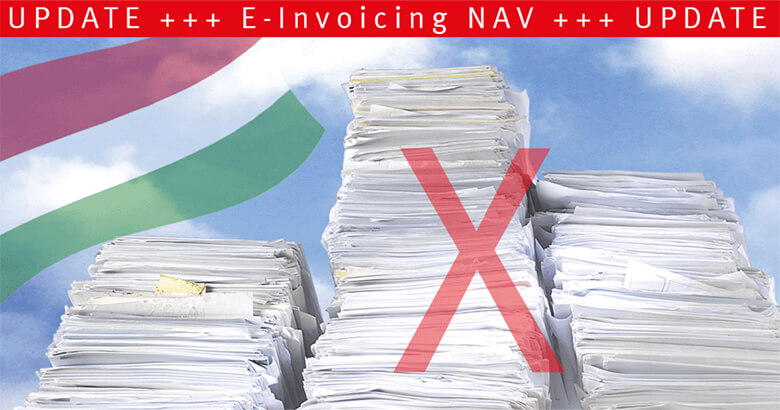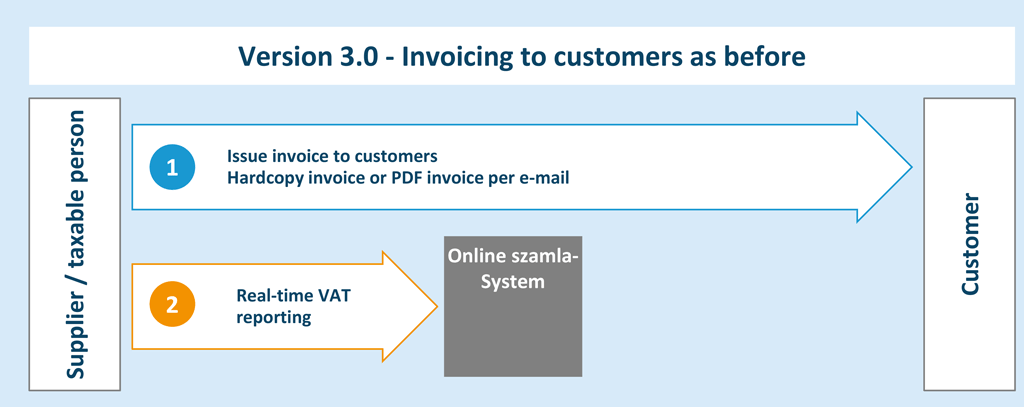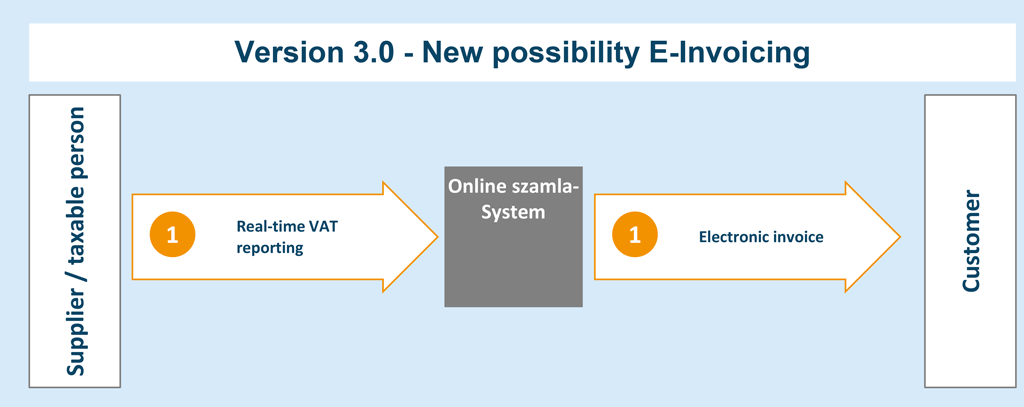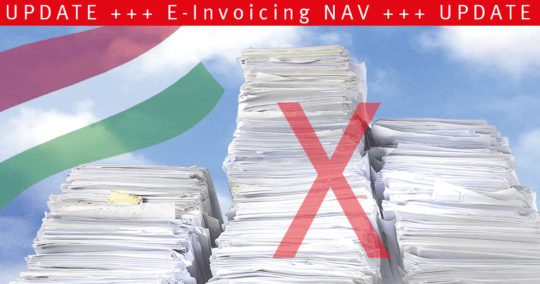When will Real Time Invoice Reporting (RTIR) become “Real Time e-Invoicing” in Hungary?

Will the new XML version 3.0 from the Hungarian Tax Authority (NAV) remain the last change for 2021? Or will B2B e-invoicing also become mandatory?
Important changes are pending regarding the interface specification for online invoices to NAV, which must be taken into account for e-invoicing. Are you prepared?
Hungary e-Invoicing Update: NAV Changes Effective 2021
A new feature is the XML file of the tax authority version 3.0 offering invoice issuers a number of options for electronic invoicing. In 2021, version 3.0 will enable companies to use the reported XML files as e-invoices.
Instead of sending an invoice to customers – as was previously often the case in hardcopy form or as a PDF invoice via e-mail – and simultaneously reporting the data to the tax authorities, companies can now exclusively report the XML file to NAV, which is then made available to customers as an electronic invoice. With version 3.0 it is still possible – as with version 2.0 up to now – to exchange invoices via hardcopy or PDF invoice (1) and at the same time report the data electronically to the NAV system (2).
From the supplier’s point of view, the most important innovation of version 3.0 is that electronic tax reporting and invoicing can be done in one step.
The benefits of e-invoicing for suppliers (invoice issuers) and customers (invoice recipients) in Hungary:
- Identity between invoices reported to NAV and invoices exchanged with customers
- Suppliers avoid for example costly post-editing corrections of invoices which have already been sent to customers and which NAV has not accepted.
- Customers have the certainty that the invoices received have been correctly verified by NAV.
- Cost reduction in invoice processing
- Suppliers avoid the parallel transmission of hardcopy invoices and PDF invoices via e-mail to customers.
- Customers can receive invoices from all suppliers from a single central system in a single electronically structured format, greatly simplifying and accelerating incoming invoice processes.
Between companies, the introduction of version 3.0 is expected to lead to a strong increase in e-invoicing – because the reporting requirement for version 3.0 enables suppliers to provide electronic invoices to their customers via the NAV system.
If companies in Hungary also use tax returns for e-invoicing, this usually has an impact on archiving for the invoicing parties and invoice recipients. This is because many paper invoices are still physically archived today. If electronic invoices are exchanged, they must be electronically archived in accordance with the legal requirements in Hungary.
As reported by the tax authorities, in September 2020 there were changes in the law on electronic invoicing regarding mandatory online transaction reporting.
The changes in detail:
- The XML of version 3.0 of the Tax Authority already contains a separate field where invoice issuers can inform their customers that the specified XML file is not just intended for reporting to the Tax Authority, but is also valid as an e-invoice for the customer.
- Invoice issuers simply need to load all data from their invoicing system that would normally appear in the invoice into the XML file. In doing so, they must indicate that it is an electronic invoice, generate a hash value from the invoice data and insert it into the XML file.
- All data that was previously included in the invoices must be inserted into the XML file in addition to the mandatory data. The tax authorities have prepared accordingly and version 3.0 of the XML schema already contains predefined fields for invoice file data, which were previously missing. For example, it is now possible to enter the order number or bank account number in a predefined field.
How can companies prepare?
- Companies must first change the current 2.0 XSD schema and migrate to the tax authority’s version 3.0 schema as required by law.
- They must then check what additional data is included in their invoices, apart from the mandatory data, and include it in the 3.0 scheme.
- Finally, they need to insert an algorithm that generates a hash code into the online reporting function for invoice data.
Due to its simplicity, e-invoicing in Hungary may become significantly more important for domestic transactions from April 1, 2021. Therefore, it should not be a surprise when companies receive electronic invoices from their suppliers or when customers request their invoices in 2021 as described above.
Furthermore, customers (invoice recipients) can receive electronic invoices from the NAV system on a voluntary basis, which may require some changes, for example:
- Customers must prepare to receive electronic invoices from the NAV system.
- Customers must integrate electronic invoices into their incoming invoice solutions and processes.
Why is the Hungarian tax authority interested in e-invoicing?
It would be naive to think that only suppliers and customers would benefit from e-invoicing via the tax authority’s system in Hungary, as NAV has been receiving tax returns on outgoing invoices (RTIR) electronically for several years now. Thus, NAV does not gain anything from electronic invoicing with version 3.0 – at least not if there had always been an identity between the invoices issued and those reported to NAV.
In reality – despite all efforts since 2018 to improve the quality of the reporting data with versions 1.0, 1.1 and 2.0 – almost every second invoice in Hungary was sent incorrectly to the tax authority. In addition, the penalties for false reports have been tightened and threats have been made to remove the VAT ID. Nevertheless, the percentage of incorrect transmissions is still in the double-digit range. This is where e-invoicing with version 3.0 can help reduce errors by making the tax return and invoice identical, if companies make extensive use of e-invoicing in Hungary. It remains to be seen when e-invoicing will become mandatory in Hungary. For example, for B2B e-invoicing, Italy first allowed the use of its SdI system voluntarily in 2017 before it became mandatory in 2018/2019. Will Hungary follow a similar path?
Introduction of the XSD interface version 3.0
Steps for the introduction of interface version 3.0:
- The productive environment for the transfer of sales tax data and invoice data with XSD version 3.0 has been available since January 1, 2020.
- The mandatory introduction of XSD version 3.0 is January 01, 2021, but version 2.0 will still be accepted until March 31.
- As of April 01, 2021 the NAV system will no longer accept data created in version 2.0.
A further release after XSD version 3.0 is currently not planned, unless there is a change in the Hungarian legislation. There are also no planned changes in the current interface specification. Therefore, testing according to the new XSD version 3.0 can be started immediately and the new version can be used productively from January 01, 2021.
As of today, developers and customers have about 3 months to implement version 3.0 and 6 months, until March 31, 2021, until version 2.0 becomes invalid.
Up-to-date with SEEBURGER Cloud Services
SEEBURGER cloud services offer a convenient, secure, scalable and high-performance entry point for e-invoicing in Hungary with full cost transparency.
Predefined formats are used in the current version. The necessary data is transferred to the Hungarian National Tax and Customs Administration (NAV). The cloud services provided and used by SEEBURGER are independent of the ERP system and can be supplemented with legally compliant archiving if required.
SEEBURGER cloud services are available for business-to-tax, business-to-government and business-to-business e-invoicing in many countries – all from a single source.
Webcast-On-Demand
Learn more about the Changed Legal Requirements for VAT Reporting in Hungary!
Thank you for your message
We appreciate your interest in SEEBURGER
Get in contact with us:
Please enter details about your project in the message section so we can direct your inquiry to the right consultant.
Written by: Andreas Killinger
Andreas Killinger joined SEEBURGER in 2014 and is a product manager, responsible for EDI services and software applications. He specialises in SAP solutions, as well as electronic invoicing (e-invoicing) for globally active customers. Following an apprenticeship as an industrial mechanic and a degree in law and administration, he had various roles in the public sector. He then worked for IBM as an SAP Senior Consultant and SAP Project Manager in international SAP projects from 1999 to 2013.







